Categories
Left column house ads
First Impressions: Tetsu
November 23, 2017 Restaurant/Bar News
 Back story: In June of 2012, chef Masa Takayama, announced plans for Tetsu, a more casual establishment than his extremely expensive sushi restaurant, Masa. The opening was repeatedly pushed back due to construction delays, including asbestos abatement that reportedly required a two-year evacuation of the entire building. (One can only imagine the litigation.) A few weeks ago, Takayama told Bloomberg that he had longed for “a place where I could enjoy a cold beer or martini and eat some delicious, flavorful food to go with it. I could never find a restaurant that satisfied exactly what I was looking for, so I decided to just build it. I wanted Tetsu to evoke the experience of dining around the robata [a charcoal grill surrounded by diners], to feel like you’re in my home.” (From 2012 to 2016, Takayama also had a less-ambitious restaurant called Tetsu at the Aria hotel in Las Vegas.)
Back story: In June of 2012, chef Masa Takayama, announced plans for Tetsu, a more casual establishment than his extremely expensive sushi restaurant, Masa. The opening was repeatedly pushed back due to construction delays, including asbestos abatement that reportedly required a two-year evacuation of the entire building. (One can only imagine the litigation.) A few weeks ago, Takayama told Bloomberg that he had longed for “a place where I could enjoy a cold beer or martini and eat some delicious, flavorful food to go with it. I could never find a restaurant that satisfied exactly what I was looking for, so I decided to just build it. I wanted Tetsu to evoke the experience of dining around the robata [a charcoal grill surrounded by diners], to feel like you’re in my home.” (From 2012 to 2016, Takayama also had a less-ambitious restaurant called Tetsu at the Aria hotel in Las Vegas.)
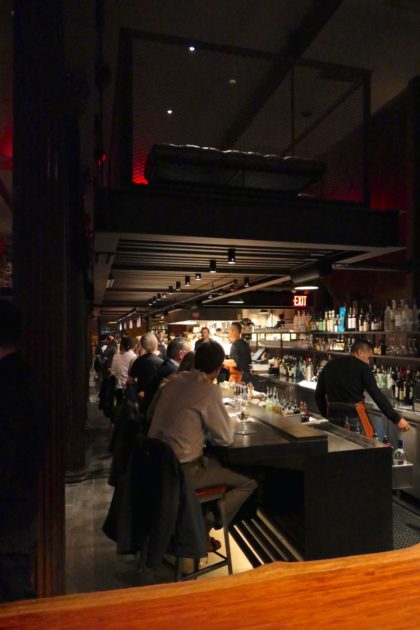
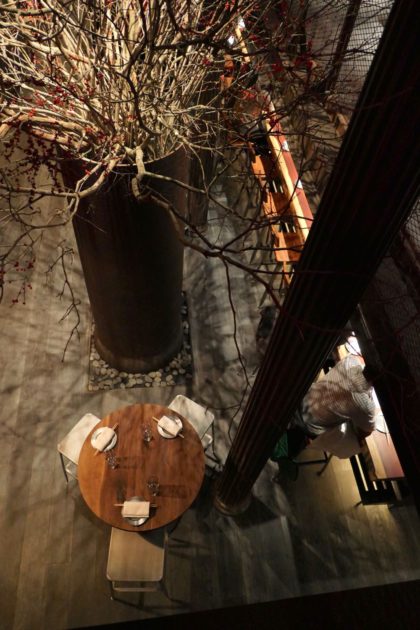 The atmosphere: I’ve never dined at Takayama’s home, but I’d be surprised if he lives in a long, dark cave of a space with double-high ceilings and a metal catwalk lounge running the length of the room. Tetsu is the opposite of cozy: It feels at first like a nightclub, with the lack of a sign (as of yet), the loud music, and the 36-foot-long bar. Diners are seated at that bar, a few high four-top tables under the catwalk, and four six-to-eight-tops in the rear. The hostess tried to put the two of us in the middle of an empty six-top, across from each other, but we insisted on an end. (The moral: Parties of two who don’t enjoy sharing a table with strangers might be happier at the bar.) Once we were seated, the nightclub vibe dissipated. The music was less intrusive—it’s more prominent in the middle of the room—and the lighting is elegantly done, in that we could see the menus and each other. Fortunately, no one joined our table until we were right about to leave, and the upstairs lounge was essentially empty, so noise wasn’t a problem. That could change when the lounge business picks up.
The atmosphere: I’ve never dined at Takayama’s home, but I’d be surprised if he lives in a long, dark cave of a space with double-high ceilings and a metal catwalk lounge running the length of the room. Tetsu is the opposite of cozy: It feels at first like a nightclub, with the lack of a sign (as of yet), the loud music, and the 36-foot-long bar. Diners are seated at that bar, a few high four-top tables under the catwalk, and four six-to-eight-tops in the rear. The hostess tried to put the two of us in the middle of an empty six-top, across from each other, but we insisted on an end. (The moral: Parties of two who don’t enjoy sharing a table with strangers might be happier at the bar.) Once we were seated, the nightclub vibe dissipated. The music was less intrusive—it’s more prominent in the middle of the room—and the lighting is elegantly done, in that we could see the menus and each other. Fortunately, no one joined our table until we were right about to leave, and the upstairs lounge was essentially empty, so noise wasn’t a problem. That could change when the lounge business picks up.

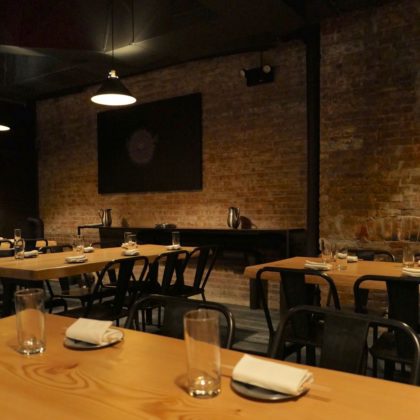 The menu: Dishes are organized by cooking method, or lack thereof: raw, salads, “sizzling,” robata grill, fried, and so on. (The menu below is one I found on Tetsu’s website last week, but it’s already out of date. The website is down, so I can’t post an updated one yet.) Our server said that the small plates are designed for sharing, but many portions are so small that if you want more than a bite or two, you have to place a double order. And while prices don’t look high, the bill adds up quickly: $7 for two small shrimp, $7 for two bites of skewered hamachi, $7 for a scoop of ice cream, $3 for pickled ginger to go with your sushi….
The menu: Dishes are organized by cooking method, or lack thereof: raw, salads, “sizzling,” robata grill, fried, and so on. (The menu below is one I found on Tetsu’s website last week, but it’s already out of date. The website is down, so I can’t post an updated one yet.) Our server said that the small plates are designed for sharing, but many portions are so small that if you want more than a bite or two, you have to place a double order. And while prices don’t look high, the bill adds up quickly: $7 for two small shrimp, $7 for two bites of skewered hamachi, $7 for a scoop of ice cream, $3 for pickled ginger to go with your sushi….
 Gold star: We enjoyed everything we ordered: Bourbon Chestnut cocktail; yuzu daikon slaw, watercress wasabi slaw; hamachi and shrimp skewers; skirt steak with garlic and soy; spicy soft-shell shrimp; tan tan mein noodles (which include roast pork); four pieces each of sushi; green pepper ice cream and olive oil cake. The standouts were the steak, the noodles, and the desserts. I’m not an aficionado of sushi, but Adam said that the uni was near Yasuda level.
Gold star: We enjoyed everything we ordered: Bourbon Chestnut cocktail; yuzu daikon slaw, watercress wasabi slaw; hamachi and shrimp skewers; skirt steak with garlic and soy; spicy soft-shell shrimp; tan tan mein noodles (which include roast pork); four pieces each of sushi; green pepper ice cream and olive oil cake. The standouts were the steak, the noodles, and the desserts. I’m not an aficionado of sushi, but Adam said that the uni was near Yasuda level.
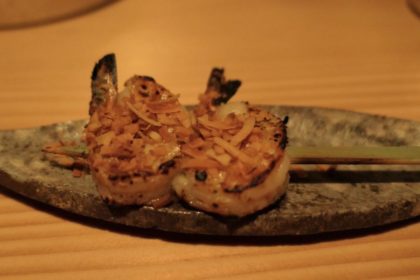
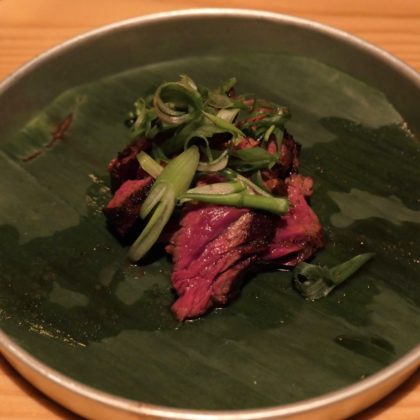
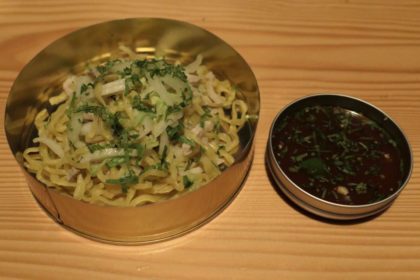 Room for improvement: There’s a disconnect at Tetsu, or maybe an identity crisis. On one hand, the restaurant is supposed to be fun, with its aggressive music (early Beastie Boys, “Fight the Power”), large lounge, and communal dining. On the other hand, all of the polish that Takayama has put into the restaurant—not to mention the ritualistic service—works against the idea of a place to grab a beer and a bite to eat. And then there’s the question of value. If I’m paying $100 per person for food alone, I need it to be not just delicious but memorable, and most of the fairly simple preparations at Tetsu don’t achieve that. Perhaps a tension between casual and serious is the goal, but I left unsure whether I was supposed to think of Tetsu as a banging place for a Friday night or a restaurant to savor high-quality ingredients prepared with care. It might benefit from becoming more loosened up or more buttoned up.
Room for improvement: There’s a disconnect at Tetsu, or maybe an identity crisis. On one hand, the restaurant is supposed to be fun, with its aggressive music (early Beastie Boys, “Fight the Power”), large lounge, and communal dining. On the other hand, all of the polish that Takayama has put into the restaurant—not to mention the ritualistic service—works against the idea of a place to grab a beer and a bite to eat. And then there’s the question of value. If I’m paying $100 per person for food alone, I need it to be not just delicious but memorable, and most of the fairly simple preparations at Tetsu don’t achieve that. Perhaps a tension between casual and serious is the goal, but I left unsure whether I was supposed to think of Tetsu as a banging place for a Friday night or a restaurant to savor high-quality ingredients prepared with care. It might benefit from becoming more loosened up or more buttoned up.
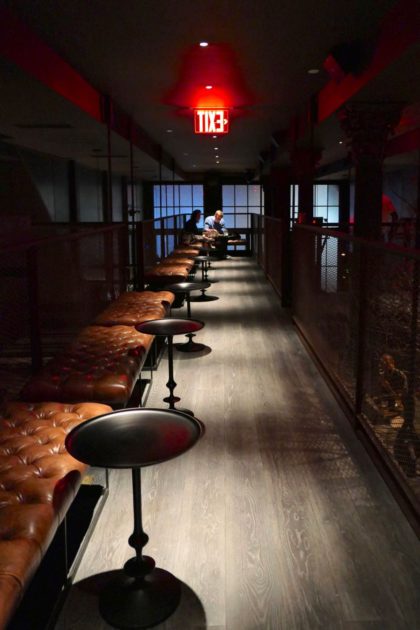 Anything else? Assuming the restrooms were downstairs, I took the staircase in the back of the restaurant. Instead, I found the fancier omakase area ($295 per person), Basement, expected to open in December.
Anything else? Assuming the restrooms were downstairs, I took the staircase in the back of the restaurant. Instead, I found the fancier omakase area ($295 per person), Basement, expected to open in December.
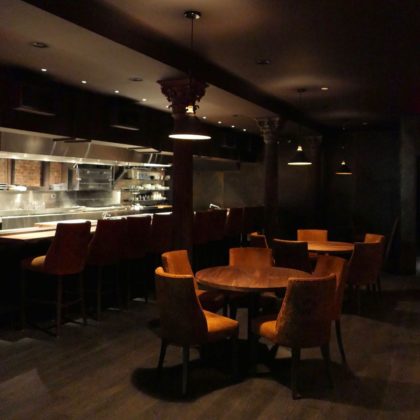 Tetsu is at 78 Leonard (between Broadway and Church); 212-207-2370; tetsunyc.com.
Tetsu is at 78 Leonard (between Broadway and Church); 212-207-2370; tetsunyc.com.
Recent New Kid on the Block / First Impressions articles:
• Shopboy
• Burger N Grill
• Jenni Kayne
• Poke Green
• Quick Cryo
• LashLove NYC
• Vin Sur Vingt
• Thomas Hayes Studio + Cipra
• The Flea Theater
• Onda Beauty
5 Comments
Subscribe
Subscribe to the TC Newsletter


















Public Enemy sung Fight the Power. Beastie Boys had (You Gotta) Fight for Your Right (To Party). Not to get too confusing but Public Enemy also had a song called Party for your Right to Fight which sampled the Beastie Boys’ Fight for Your Right.
I was citing two examples, not saying that Beastie Boys did “Fight the Power.”
Ah, understood! I was just using this as an opportunity to show off my knowledge of old school hip hop. ;)
“$295 per person”!!!!!
We don’t spend that much in a month on food.
I know you’re never supposed to say this, but I’m a little bit Japanese fooded out. This place sounds like way too expensive Izakaya upstairs and ridiculously over-priced omakase downstairs. As a mostly-vegetarian who will compromise with a bit of seafood if I have to, it bothers me more and more to make that compromise as the oceans get closer and closer to mass extinction (even the “dreams of sushi” guy in the documentary admitted sushi is terrible for the environment and should be eaten only occasionally.) And the whole Japanese food snobbery thing just doesn’t do it for me. Izakaya is about drinking beer with friends (and I have lots of Japanese friends) and munching on fairly humble fare – and there are a lot of good spots around the city that provide just that. And Omakase is a rare once in a long while chance to sit with a chef and try little fancy tidbits, but when the price gets into the stratosphere, the whole phenomenon starts to look threadbare and exploitative – overhyped. Yeah, it can be fun, but no, omakase isn’t the end all and be all of life. My husband goes to Japan a lot on business, and so, sure, I’ve learned not to go to sushi restaurants where everyone is speaking Cantonese (and yes, my husband is Cantonese, so we know.) On the other hand, succumbing to the insanity of Japanese snobbery and salesmanship can get a little out of hand, too. There’s got to be a middle ground.